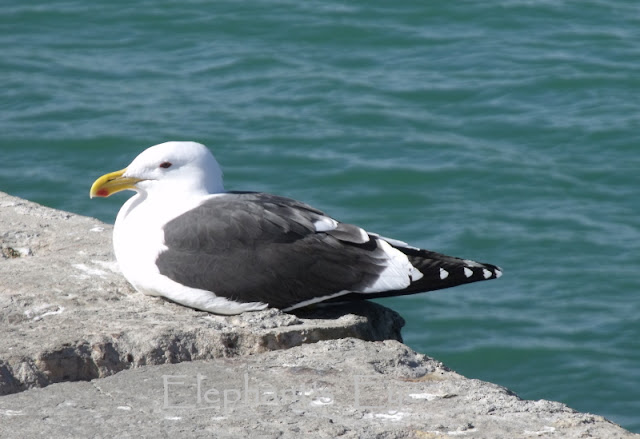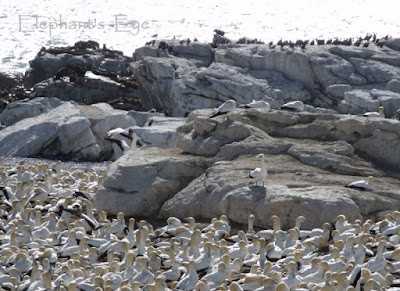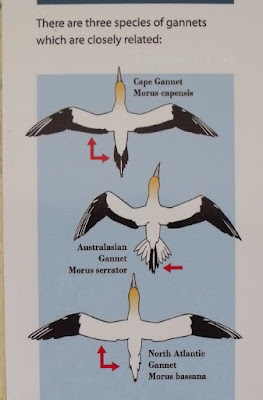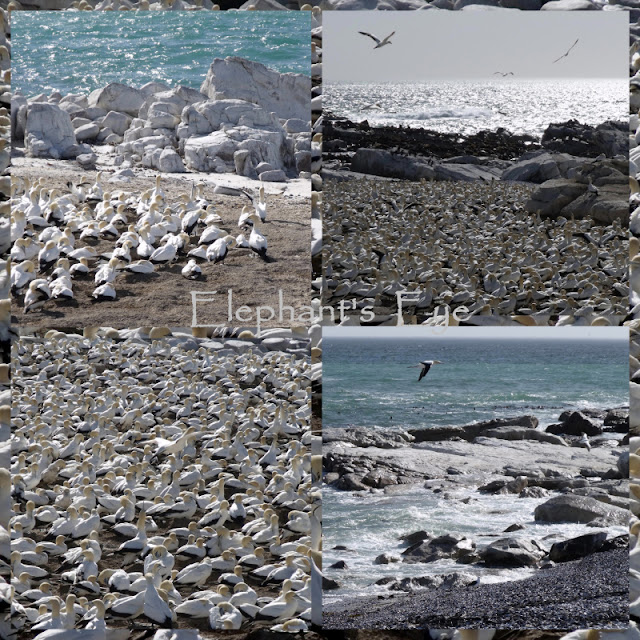Bird Island, Lambert's Bay
By Diana Studer
- gardening for biodiversity
in Cape Town, South Africa
Down Verlorenvlei-spring-flowers,
past the train,
we went to see the birds at Lambert’s Bay in August 2010.
Lambert’s Bay is one of the West Coast’s traditional fishing villages morphing into tourist and holiday homes. Our Wild Card got us
free entry to Bird Island. Connected to the shore by a causeway - easy for the
tourists, not ideal for the birds.
Penguins were
made to keep warm while fishing in cold water. Nesting on hot land is hard to
do. They used to dig burrows in guano, when there was a layer of guano to dig
into. Now they seek shelter from the sun, and their enemies, for their eggs and
chicks.
Guano, a Peruvian word, was called White Gold in the 1800s.
In 1843 three ships came from Liverpool to collect guano. The first was
wrecked, the second turned back, and the third didn’t get a full load. Yet at
ten British pounds a ton, it still made a profit! Britain gave Namibia to
Germany, keeping the guano islands. Then in the 1950s – artificial fertiliser.
Kelp gulls will steal eggs or chicks from the other birds if
you are unkind/careless enough to disturb the parents. They feed on the
discards from the potato and fish factories in town. See the red spot on the
beak? The chicks peck here, and dinner is delivered. Coming up right now …
Seals were a big problem, terrorising the birds to such an
extent that they abandoned the island to them. It is shocking to suddenly
recognise those dark shapes on the far rocks, as … seals!
Bird Island is mostly about Cape Gannets. The North Atlantic
and Australasia each have their own species of gannet. Ours stretches around
the coast of southern Africa, from the Spanish Sahara on the West, to
Mozambique on the East. They have also been seen in Kenya, Australia and
Scotland.
Since Cape Gannets nest in guano (not collecting material as
other birds do) they are tightly packed together. As they fly home, bird’s eye
view, they know exactly where their nest is. Frightfully polite when coming
home, they circle low, and warn the neighbours and spouse – 15A coming H O M E!
A few more circuits, and then, they land. Then again to warn the neighbours
– I'm pulling out of the garage now – they skypoint, before leaving for
the next shift.
To ease the stress of living on top of the neighbours, pairs
practice bill scissoring, a ritual dance.
This colony formed in 1912. Predators coming over the causeway are an ongoing threat to the birds. Young male Cape Fur Seals develop skills at attacking and killing cormorants, penguins and gannets. The threat of an oil spill is ever-present, but unpredictable. Both the Cape Gannet and the African Penguin are in competition with the fishing industry for Sardine and Anchovy. Guano scraping has been discontinued, but human disturbance remains a threat. Please stay on the paths on the island - From Animal Demography Unit at UCT
(If you mouse over teal blue text, it turns seaweed red
Those are my links.
To read or leave comments, either click the word Comments
below,
or click this post's title)









So interesting...lovely photos and learning about a species that I was not familiar with! :)
ReplyDeleteSuch an interesting post. I am always amazed when i hear stories about birds/animals that have nuanced behaviors to protect their young and live amongst their species in peace. I wasn't aware of a lot of the gannat behavior your wrote about. We were just at the coast to see the nesting of the Oystercatchers. I was happy to see a naturalist there keeping people far away from the nesting birds, while also providing a couple of pairs of free binoculars on a stand for people to use and return. The gentleman told us he had never lost a pair in 15 years. That is the Oregon I love. I also learned this past year—in the Hawaiian Islands off the coast of Maui, that early spring provides a shallow area for 70% of the world's gray whale population. It is warm, relatively contained and along the migration route. What a joy to see them! Did you know they have a kind of "uncle whale" (my word), an older male who keeps the young males away from breeding females? How much nature knows that we don't.
ReplyDeleteWe have African black oystercatchers. Since beaches have been closed to offroad traffic, idiots in dune buggies, and grumbling leisure fishermen - the endangered birds are recovering. Such beautiful birds in black and red!
DeleteFascinating Diana- I remember reading about the expense of guano but at what a cost to sailors and now I read, gannets. Our herring gull has the same red spot for the same purpose and found an interesting article on interbreeding between herring & kelp gull - at least the chicks will know what to do
ReplyDeleteOh, I want to go there! I always think this when I read your posts, so someday I hope I'll be able to travel to S. Africa. I always find the maps showing migration routes fascinating. Migrating species really cover so much ground (and air)! Interesting information about the bill-scissoring: I remember seeing that on various nature shows. A fascinating post!
ReplyDeleteI in turn am amazed that Monarch butterflies, can and do, migrate. Battling to find any milkweed on their long journey.
DeleteBird Island just outside Algoa Bay off Port Elizabeth is said to be the biggest breeding colony of gannets in the world. Pity only a few people get to see it though as it's too far for a leisure cruise to do regular trips out there from PE.
ReplyDeleteWow!!! South Africa is really beautiful.
ReplyDeleteI'm so glad that there is a conscious effort to preserve the habitat of these birds.
This is something all Africans must learn to imitate.
Your photography is really inspiring, and thanks for given details of the cameras used as well.
This is fantastic. I've seen it on tv quite often - and you are living there. Must be very impressive. The wreath is realy easy done. I took a stronger wire to make a circle and fixed the flowers with florist wire. Place the flowers on the right position and wind around. Easy!
ReplyDeleteHappy days and a wonderful winter
Elisabeth
My first commenter from South Africa I believe and such an interesting blog to find in return thank you. I have been studying the old header and have seen more than one elephant!
ReplyDeleteA lot of information in your post Diana, I have never heard of them, they do look similar to our west coast gulls...but prettier. Poor little things, no matter where they turn it's like living in a condo.
ReplyDeleteJen
some safety in numbers. And they seem surprisingly peaceable and competent at 'city' living.
DeleteSo interesting about the guano. I had no idea it used to be so in demand and valuable! What a great and interesting trip!
ReplyDeleteI think I can almost remember seeing little bags of guano for sale at the nurseries when I tagged along with my parents as a small child. Now we have choices, mushroom compost, chicken manure ... and the certified organic that I use for the roses.
DeleteI am with Beth, I would love to visit there...what an amazing sight and site.
ReplyDelete